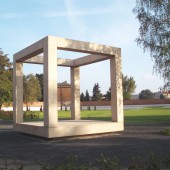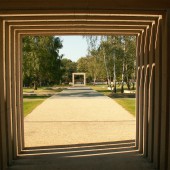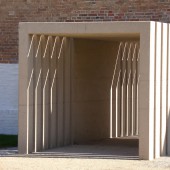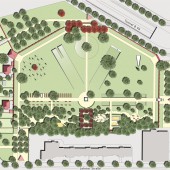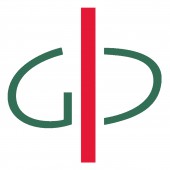Historical Park Park and Memorial by Udo Hubert Dagenbach Glada-Berlin |
Home > Winners > #54366 |
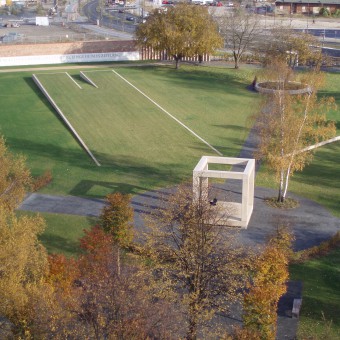 |
|
||||
| DESIGN DETAILS | |||||
| DESIGN NAME: Historical Park PRIMARY FUNCTION: Park and Memorial INSPIRATION: This project shows a way how to combine the design for a recreational park with a memorial. With means of land art, and minimal art the story of the historically meaningful space is told by forming an architectural garden that allows both recreation and memory. UNIQUE PROPERTIES / PROJECT DESCRIPTION: The Prussian prison was constructed from 1842 to 1849 in Berlin. At the end of World War 2 political prisoners have been captured and tortured there. In 1958 the buildings, except the outer wall, have been destroyed. After the political reunion of the two parts Berlin, the city contracted the Glasser and Dagenbach with the planning. The star shaped buildings are conveyed through a series of elevated and sunken grass sections and hedges. The prisons once central observation area is symbolized by a concrete cube as center of an architectural garden with elements of Land and Minimal Art. OPERATION / FLOW / INTERACTION: The prison park is locked daily at night for security purposes. So the prison function stays somehow alive. The park needs some protection at night as the central station is close by. It has 3 entrances, on each entrance information pannels are installed, explaining the historical and architectural story of the park. PROJECT DURATION AND LOCATION: The project started 1990 and was finished after 17 years in 2007 in Berlin. The planning process started with a research contract and then extended to a planning contract. The construction took 3 years. |
PRODUCTION / REALIZATION TECHNOLOGY: The parks architectural elements are made out of sandblasted, beige coloured concrete. The concrete has the same colour like the the joints of the old remaining brick wall which is left from the former prison. The existing trees are left as visible layers of time which covered this place throughout the postwar time until the fall of the Berlin Wall. Red leafed book trees as hedges show the former prison cell structure. Column like growing Junipers replace the former yard birds walking in the triangular shaped outdoor yards. SPECIFICATIONS / TECHNICAL PROPERTIES: The whole park area has a size of roughly 2,8 ha. About 330 m of the old prison wall was restored. It is about 4 to 5 m high. To block the view against existing buildings from the 1970ies we planted many oevergreen pine trees. In a prison cell a sound installation is started when you enter the cell. Poem from prisoners and knocking sound codes can be heard about 5 minutes. A poem from a former prisoner during the Nazi Period is written on the inside of the prison wall. TAGS: historical park, Berlin, Geschichtspark Moabit, Moabit Prison, memorial RESEARCH ABSTRACT: A long process of both public and internal discussion in the team developed the design direction. The client wanted to reach a combination of both recreational park and memorial. This has not been realized before. It took a long time of thinking what means will be used to tell the history of the prison and yet provide a recreational landscape. CHALLENGE: Only prison walls where left . The prison as building and its historical context was not visible any more. The story of the prison is transcripted in a public park through land and minimal art, without a didactic approach. You can receive just as much information as you like. The design completely relies on the impression of the architectural and vegetative elements. We avoided any mannerist attitude; it took a lot of energy to reject political influence from outside and to keep the neighbors and interested citizens informed. ADDED DATE: 2017-02-22 09:02:47 TEAM MEMBERS (13) : Architect: Alexander Khomiakov , Landscape Architect: Martina Levin, Landscape Architect:Volker Roehrs, Landscape Architect: Sabrina Schroeder, Landscape Architect: Katania Schulz, Drafts women: Marina Kanzler, Landscape Architect: Andreas Steiner, Landscape Architect: Leighton Pace, Landscape Architect: Sabine Linke, artist for sound installation and choice of poem: Christiane Keppler, artist for inclusion of neighbourhood kids: Serge Petit, artist for inclusion of neighbourhood kids: Gabriele Roßkamp and artist for inclusion of neighbourhood kids: Bärbel Rothaar IMAGE CREDITS: image 1: Udo Dagenbach, topview,2007 image 2: Udo Dagenbach, panopticum,2007 image 3: Udo Dagenbach, entrance, 2007 image 4: Udo Dagenbach, entrance 2, 2007 image 5: Udo Dagenbach, layout plan, 2007 PATENTS/COPYRIGHTS: all copyrights belong to Udo Dagenbach, glasser and dagenbach, 2006 |
||||
| Visit the following page to learn more: http://www.glada-berlin.de/ | |||||
| AWARD DETAILS | |
 |
Historical Park Park and Memorial by Udo Hubert Dagenbach Glada-Berlin is Winner in Landscape Planning and Garden Design Category, 2016 - 2017.· Read the interview with designer Udo Hubert Dagenbach Glada-Berlin for design Historical Park here.· Press Members: Login or Register to request an exclusive interview with Udo Hubert Dagenbach Glada-Berlin. · Click here to register inorder to view the profile and other works by Udo Hubert Dagenbach Glada-Berlin. |
| SOCIAL |
| + Add to Likes / Favorites | Send to My Email | Comment | Testimonials | View Press-Release | Press Kit |
Did you like Udo Hubert Dagenbach Glada-Berlin's Landscape Design?
You will most likely enjoy other award winning landscape design as well.
Click here to view more Award Winning Landscape Design.


